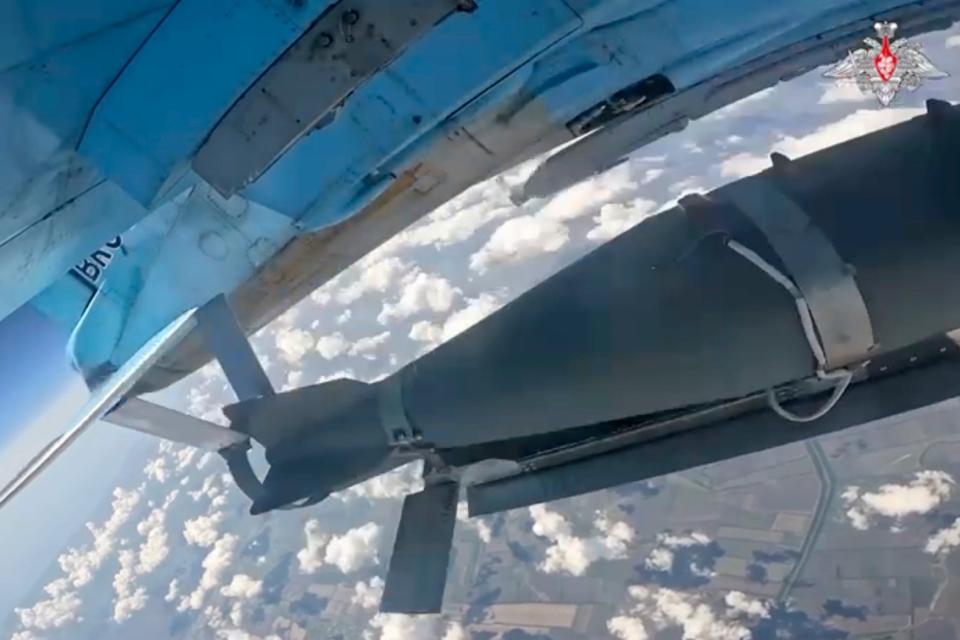-
Russia has been reluctant to use its glide bombs in Kursk, according to experts.
-
Ukraine has advanced into Russia to create a buffer zone, and Moscow has struggled to respond.
-
Russia’s weak air control systems mean it struggles to use the bombs accurately, an expert told BI.
Russia is unable to fully take advantage of one of its most effective weapons against Ukrainian forces advancing in its territory, according to a military strategy expert.
That’s likely because Russian systems aren’t good enough to ensure that it won’t hit itself, he said.
Russia has increasingly fired glide bombs at Ukrainian territory in its invasion of the country.
The bombs are equipped with guidance systems that allow them to be launched from jets at a distance. They’re difficult to stop, and Russia has been making them more powerful: Its newest model weighs 6,600 pounds.
But Russia has not been using the bombs at the same scale against Ukrainian forces that crossed the border into Russia earlier this month.


Mark Cancian, a retired Marine Corps colonel and a senior advisor at the Center for Strategic and International Studies, said Russia hasn’t been seen heavily using air power or glide bombs against Ukrainian forces in Kursk.
“I think that’s a reflection of a weak air control system,” he said.
While the US and NATO “have very sophisticated mechanisms” and a “very elaborate, well-trained system” between aircraft and a control center to ensure they don’t hit anything friendly, that’s not the case for Russia.
The US is “pretty good at it. The Russians are not,” Cancian said.


Cancian said that Russia is able to heavily use glide bombs in Ukraine because the front is static and largely unmoving, so Russia can get away with a weaker control system and less unintended damage.
He said Russia’s relative caution in Kursk “is a reflection of inability, their weakness in using air in support of ground forces.”
Not at scale
Some glide bomb usage has been recorded in Kursk, but not to the scale of elsewhere.
Ukraine’s military said on Wednesday that Russia had launched 27 glide bombs in the region; it’s not clear if that figure is in total or in one day.
Either way, it’s a much smaller number than what Russia is reportedly firing at targets on Ukrainian territory. Russia used 750 glide bombs on Ukrainian cities and villages last week alone, according to Ukrainian President Volodymyr Zelenskyy Sunday.
It’s also fewer than the 50 glide bombs Russia has reportedly been firing daily into Ukraine’s Sumy region, which neighbors Kursk.


“The Russians are hamstrung in one way, in the sense that they can’t drop these fab gliding bombs in Kursk as they have done in parts of Ukraine, especially in the eastern front, because obviously, it’s their own territory,” said Rajan Menon, a senior research scholar at Columbia University’s Saltzman Institute of War and Peace Studies.
“They’ll get a lot of people killed. Civilians.”
George Barros, a Russian military expert at the US-based Institute for the Study of War, told BI that Russia is so far not using the bombs in Kursk “at scale.”
Russia’s attacks in Ukraine, Barros said, “completely obliterate entire neighborhoods and towns over the span of just days.”
“The Russians decisively are not doing that in Kursk,” he added.
But as Ukraine continues its incursion, Russia’s risk calculations may change.
Russia has dropped bombs on its territory and destroyed its own weaponry since launching its invasion of Ukraine. This includes shooting down its own fighter jets.
But these were relatively isolated incidents rather than something that was happening as a result of a new strategy, such as using glide bombs in Kursk.
Barros said Russia was afraid of the “political considerations” that would come with targeting its own territory.


Meanwhile, Ukraine has started to use glide bombs against Russia in Kursk.
Zelenskyy said the incursion aims to create a “buffer zone” to minimize Russia’s ability to harm Ukraine.
However, warfare analysts also told BI that Ukraine likely wanted to stretch Russia’s forces and give fresh motivation to its troops and allies.
Barros said it’s not clear how the fast-moving operation will end. But he said that so far, it’s been a positive for Ukraine after months of grinding warfare with little territory changing hands.
Ukrainians, he said, “are no longer stuck in the rut where they no longer have the initiative.”
“It is now no longer the Ukrainians lying on their back for nine-plus months at a time simply trying their best to triage,” he said.
Read the original article on Business Insider







